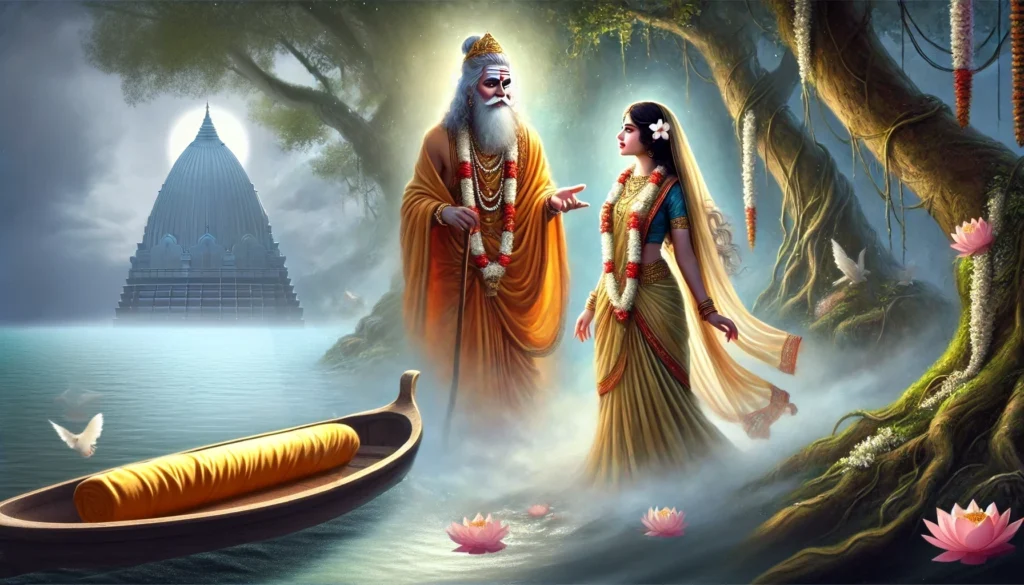Rishi Parashara, a monumental figure in the field of Vedic astrology, is best known as the father of Jyotish Shastra. His work, the Brihat Parashara Hora Shastra, laid the foundation for Vedic astrology, influencing generations of astrologers. Born into a lineage of sages, Parashara’s teachings transcended the limits of astrology, shaping the spiritual and intellectual fabric of ancient Hindu society. His contributions continue to resonate today, making him one of the most revered sages in Hindu tradition.
RISHI PARASHARA
Rishi Parashara, was a renowned maharishi in ancient Hinduism, is widely recognized for his extensive contributions to Vedic literature and astrology. He is credited with authoring the Brihat Parashara Hora Shastra, one of the foundational texts of Vedic astrology, and is hailed as the father of Jyotish Shastra. As the son of Sage Shakti Muni and the grandson of the great Rishi Vasishtha, one of the revered Saptarishis, Parashara’s life and works have left an indelible mark on Hindu tradition and society.
Parashara’s writings and teachings cover multiple disciplines, including dharma (righteous living), ethics, Ayurveda (traditional Indian medicine), and astrology, thus playing a pivotal role in shaping the spiritual and intellectual fabric of Hindu society.
STORY OF RISHI PARASHARA
The life of Rishi Parashara is filled with stories of immense spiritual significance. His birth story is tied to a tragic event when his father, Shakti Muni, was killed by a Rakshasa (demon). After this, Parashara was raised by his mother, Adrishyanti, and his grandfather, Vasishtha, who was deeply pained by the death of his son. One day, while meditating in seclusion, Vasishtha was surprised to hear the recitation of Vedic hymns coming from Adrishyanti’s womb—this unborn child, Parashara, had already started chanting Vedic mantras even before birth. This event was a sign of Parashara’s extraordinary intellect and spiritual power from a young age.
When Parashara learned of his father’s untimely death, he vowed to avenge his death by performing the Rakshasa Satra Yagya, a sacrificial ritual aimed at destroying all Rakshasas. The ritual was causing havoc among the Rakshasas, who began to perish one after another in the sacrificial fire. However, Maharishi Pulastya intervened and persuaded Parashara to stop the yajna, appealing to him on the grounds of non-violence and compassion. Parashara abandoned his quest for revenge, demonstrating great restraint and wisdom, traits that would define his life and teachings thereafter.
MAHARISHI PARASHARA AND VEDIC ASTROLOGY
Maharishi Parashara’s contributions to Vedic astrology are immense. His most well-known work, the Brihat Parashara Hora Shastra,continues to be one of the most authoritative texts on Hindu astrology, laying the foundation for what is now known as Jyotish Shastra. In this treatise, Parashara systematically expounded on the principles of planetary positions, Nakshatras (lunar mansions), and astrological yogas (planetary combinations) that govern human destiny. The text offers detailed explanations on the effects of planetary influences on various aspects of life, including health, wealth, marriage, and spirituality .
The Brihat Parashara Hora Shastra also emphasises the importance of using astrology as a tool for better understanding one’s karma and dharma, guiding individuals toward righteous living by aligning themselves with the cosmic order . His work has continued to influence astrologers and scholars, making Parashara the undisputed father of Vedic astrology.
Know More about basics of Vedic Astrology 👇:
https://astroparasar.com/the-basics-of-vedic-astrology/
RISHI PARASHARA AND SATYAVATI
A noteworthy chapter in Parashara’s life is his relationship with Satyavati, a fisherwoman also known as Matsyagandha, due to the strong fishy odor that emanated from her. Satyavati used to ferry people across the Yamuna River, and it was during one of these crossings that Parashara became captivated by her beauty. Parashara approached her with his desire, but Satyavati hesitated due to her caste and societal status.
However, Parashara assured her that their union would be kept hidden, and he fulfilled her three requests: Firstly, he created a fog that enveloped the river, ensuring that no one would witness their encounter. Secondly, he promised that her virginity would remain intact after their union, a promise he kept with his yogic powers. Lastly, he blessed her by transforming her fishy odour into a divine fragrance that would attract attention. From their union, a son was born—Ved Vyasa, one of the greatest sages in Hindu tradition, who would later compile the Vedas and author the Mahabharata, one of India’s most revered epics .
PARASHARA RISHI FAMILY TREE
Parashara Rishi’s lineage is one of the most revered in Hindu tradition. His grandfather, Vasishtha, was a legendary sage and one of the Saptarishis, renowned for his wisdom and spiritual authority. Parashara’s father, Shakti Muni, though tragically killed by a Rakshasa, was also a respected sage. Parashara himself became one of the foremost authorities on Vedic knowledge, and his son, Ved Vyasa, is credited with compiling the four Vedas, authoring the Mahabharata, and organising the Puranas.
This lineage of Vasishtha, Shakti Muni, Parashara, and Ved Vyasa forms a continuous line of spiritual and intellectual inheritance, whose influence has shaped the course of Hindu thought for millennia. Their combined wisdom has left an enduring legacy in Hindu philosophy, literature, and astrology .
Watch our video on ”Maharishi Parashara”:👇
FAQS





